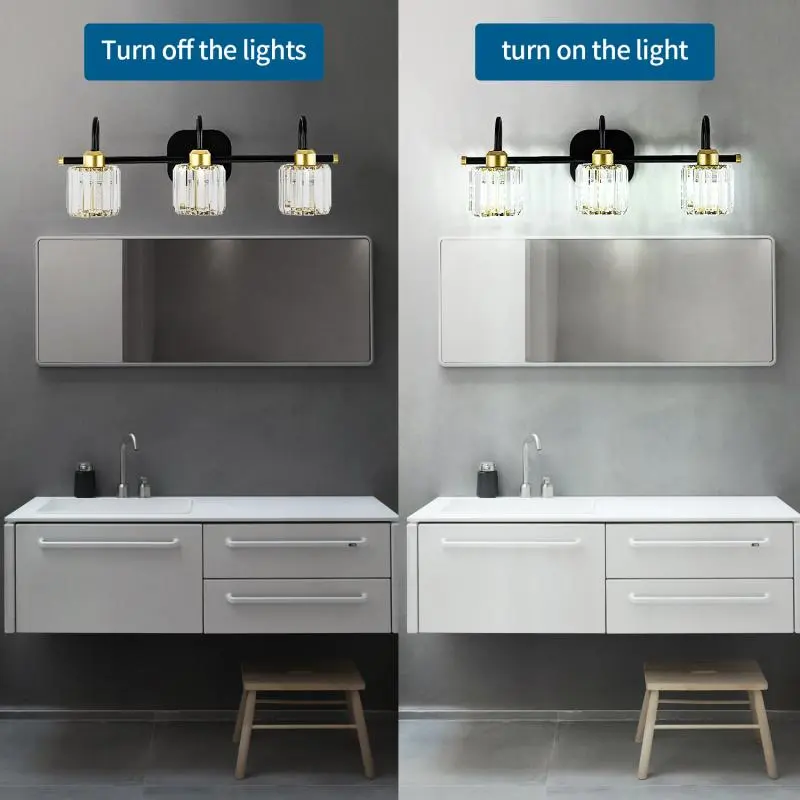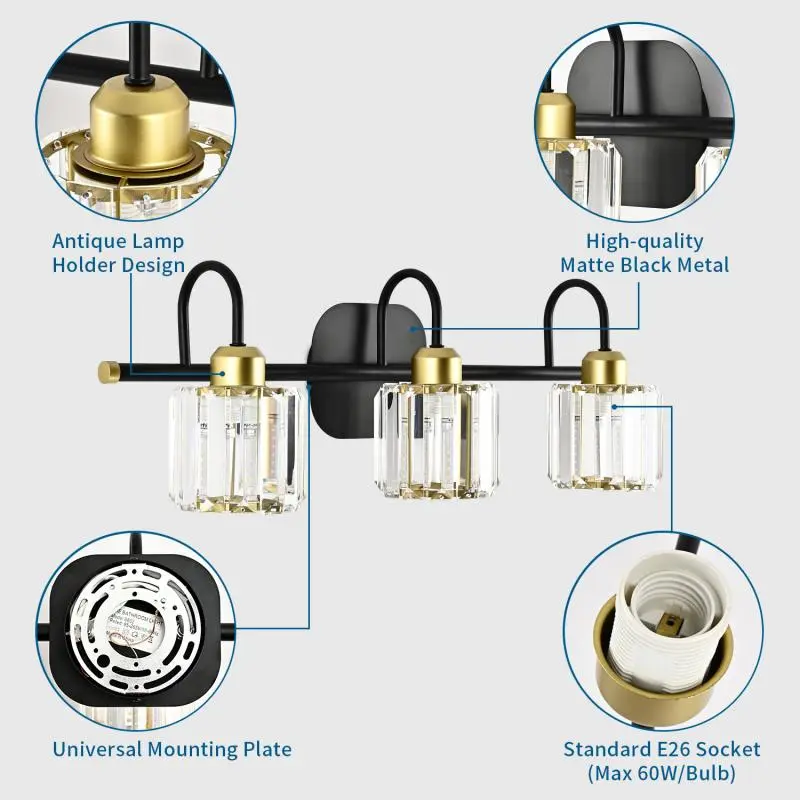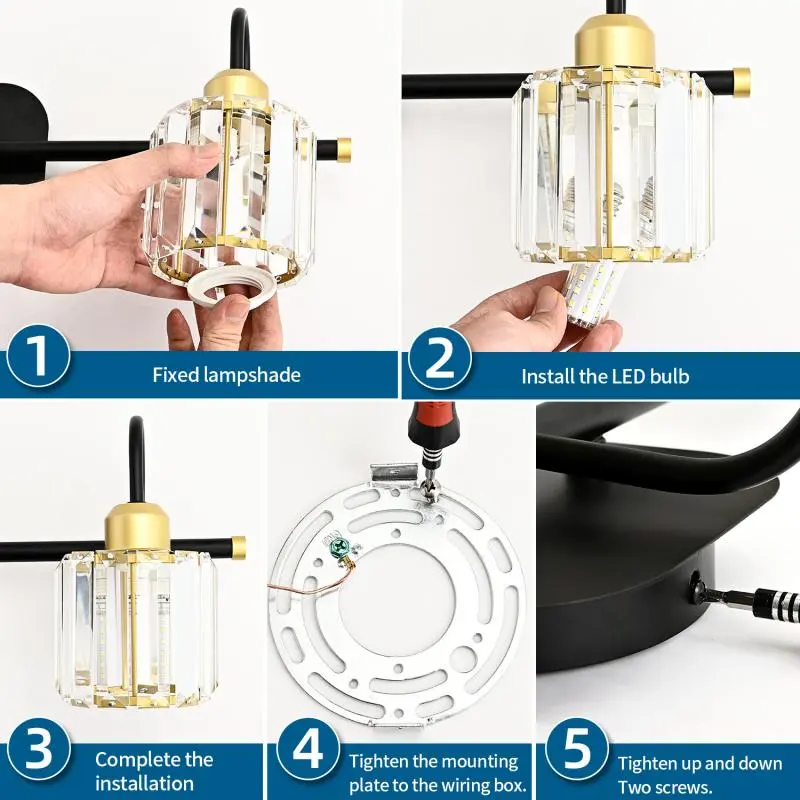How many watts should a bathroom vanity light be?
The bathroom vanity area has always been a focal point. It not only impacts daily washing and makeup application, but also directly affects the comfort and safety of the space. A common and straightforward question is: How many watts should a bathroom vanity light be?
The typical professional answer is approximately 60W. In practice, however, this wattage is closely related to the configuration and optical characteristics of the vanity wall light.
This article, using the logic of a news report, will thoroughly analyze the scientific basis behind the recommended wattage of "around 60W." By integrating lighting principles, light source selection, installation environment, protection requirements, and actual user needs, this article systematically addresses this question.

Why emphasize wattage?
When discussing vanity wall lights, wattage (W) is the most intuitive factor for consumers and designers. Wattage represents the lamp's rated input power, which is directly related to luminous flux, illumination level, and energy consumption.
• Too low a wattage: Insufficient light, unable to illuminate the face, blurring makeup details and even posing a safety hazard.
• Too high a wattage: Not only does it waste energy, it can also cause glare, excessive brightness, and even overheating.
Thus, the key to the question, "What wattage should a bathroom vanity light be?" lies in finding the optimal balance between ensuring effective facial illumination, comfort, and energy efficiency. The 60W range is based on these considerations.
Why is a 60W vanity wall light recommended?
1. Lighting Parameter Conversion
Based on traditional incandescent lamps, the luminous flux of a 60W incandescent lamp is approximately 700–800 lumens. This level of luminous flux provides 500–1000 lux of facial illumination for a dressing area of approximately 2–4 square meters, meeting professional vanity lighting requirements.
2. LED Light Source Equivalency
In modern lighting, vanity wall lights mostly use LED light sources. LED luminous efficacy typically ranges from 80–120 lumens/W. This means that only approximately 8W–12W of LED power is needed to achieve the same luminous flux as a traditional 60W incandescent lamp.
Therefore, the "approximately 60W" in the title does not necessarily require a 60W LED, but rather corresponds to the equivalent brightness standard of a traditional light source. When purchasing a vanity wall light, consumers should understand that a light source with a luminous flux of approximately 800 lumens is sufficient.
3. Facial Lighting Requirements
Delicate tasks such as applying makeup and shaving require high facial illumination. According to ergonomic and lighting design standards, localized facial illumination should be at least 500 lx. The output of a single 60W equivalent light source precisely meets this requirement and is therefore widely recommended.

Vanity Wall Light: Relationship with Wattage Configuration
1. Single-Lamp Configuration
If the bathroom vanity is small (mirror width ≤ 60cm), a single vanity wall light can meet basic lighting needs. In this case, a 60W equivalent luminous flux is sufficient.
2. Symmetrical Two-Lamp Configuration
For medium-width mirrors, a common practice is to install two vanity wall lights symmetrically on either side. In this case, the wattage of each fixture can be moderately reduced (30W–40W equivalent), bringing the total luminous flux closer to 60W.
3. Three-Lamp or More-Lamp Configuration
In double bathrooms or large mirrors, three or more vanity wall lights are typically required. While maintaining the overall luminous flux at 60W equivalent, supplemental lighting can be added based on space requirements. The rated wattage of each fixture is correspondingly lower (15W–20W LEDs are sufficient).
Vanity Wall Light: Key Parameters Affecting Wattage Selection
Besides the basic standard of "around 60W," the following lighting and environmental parameters also influence the actual wattage selection:
1. Color Temperature (CCT)
• Recommended range: 2700K–4000K.
• Higher color temperatures (cool white light) appear brighter at the same wattage, while lower color temperatures (warm white light) appear softer.
2. Color Rendering Index (CRI)
• Recommended value: Ra ≥ 90.
• A high CRI helps accurately distinguish colors when applying makeup, which is especially critical for vanity wall lights.
3. Illumination Distribution
• Single-point illumination requires higher wattage to cover the face; multi-point distribution can achieve uniform illumination using multiple lower-wattage light sources.
4. Bathroom Space Reflectivity
• Bathrooms often have highly reflective materials such as tiles and mirrors, so a moderate reduction in wattage can achieve the desired effect.
Conversely, if the background absorbs light (such as dark tiles), the wattage should be increased to compensate for the luminous flux.

Vanity Wall Lights: Safety and Wattage Selection
The bathroom environment is unique, characterized by high humidity and conductivity, placing extremely high demands on lamp safety. Therefore, when selecting the wattage of a vanity wall light, safety considerations must also be considered:
1. IP Rating
• It is recommended to select vanity wall lights with a rating of at least IP44 or higher, ensuring splash protection.
• The higher the wattage, the greater the heat generated, requiring more robust heat dissipation and insulation design.
2. Electrical Wiring
• When configuring multiple lamps, the total power is distributed, but the number of wiring connections increases, so electrical regulations must be adhered to.
• Professional installation is recommended to avoid overheating or short circuits caused by incorrect wiring.
3. Heat Dissipation and Lifespan
• Although LED vanity wall lights have lower wattage, they also require good heat dissipation.
• Excessive wattage and insufficient heat dissipation can shorten lifespan and even cause potential safety hazards.
Bathroom Vanity Lights: Wattage Reference Table for Different Configurations
Configuration | Recommended single lamp power (LED equivalent) | Total power (equivalent to an incandescent lamp) | Suitable for: |
| Single light above | 8W–12W (60W equivalent) | Approximately 60W | Small bathroom mirror |
| Dual lights symmetrical | 5W–8W per lamp | Approximately 60W | Medium bathroom mirror |
| Three lights combination | 5W–7W per lamp | Approximately 70–90W | Large mirror/double use |
| Four lights or more | 4W–6W per lamp | Approximately 80–100W | Luxury bathroom |
As shown in the table, "approximately 60W" is a baseline wattage. In a multi-lamp setup, this wattage will be distributed across each vanity wall light.

Bathroom Vanity Lights: How to Avoid Wattage Selection Mistakes?
1. Don't Just Look at Wattage
Wattage is only an indicator of energy input; the true luminous flux (lumens) determines brightness. When purchasing a vanity wall light, focus on lumens, not just wattage.
2. Avoid Single-Point High-Wattage Lighting
A single high-wattage lamp can easily cause glare and uneven illumination. Distributed, medium- and low-wattage lighting is more effective.
3. Ignore Reflective Bathroom Environments
For bright tile and large mirrors, the wattage can be adjusted down slightly; for darker decor, the luminous flux needs to be increased.
4. Ignore IP65 Rating
Don't sacrifice safety when choosing wattage. All vanity wall lights designed specifically for bathrooms must have a qualified waterproof design.
Back to the title: "What wattage should a bathroom vanity light be?"
—The professionally recommended answer is: approximately 60W.
This wattage does not directly refer to the LED power, but rather to the luminous flux equivalent of a traditional 60W incandescent bulb, or approximately 800 lumens.
In practice, single-, dual-, or multi-lamp vanity wall light configurations can be flexibly adjusted based on mirror width, space size, and usage requirements. The overall luminous flux should aim for facial illumination of 500–1000 lx.
While meeting power requirements, color temperature, color rendering index, IP65 protection level, and electrical safety must also be considered.
What certifications does Huari Lighting hold?
To meet global market demands, Huari Lighting products are certified with CE, RoHS, and ERP standards. Our company is also ISO 9001 and ISO 14001 accredited, ensuring that every stage of production—from material supply to shipment—follows strict quality systems.
Buyers benefit from this by purchasing LED products that meet safety and energy efficiency requirements. When you buy from us, you’re not only choosing a cheap and reliable Chinese factory but also a trusted supplier with proven quality.
